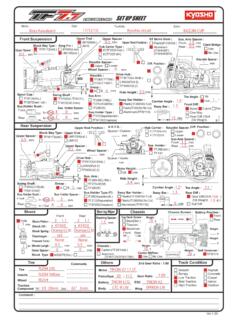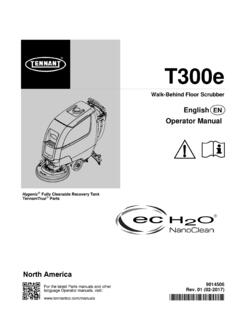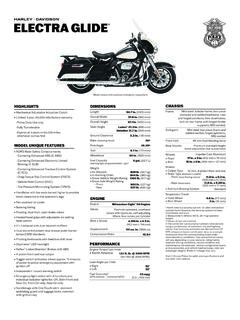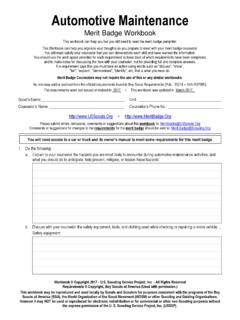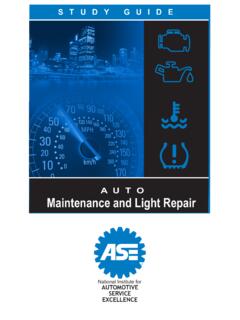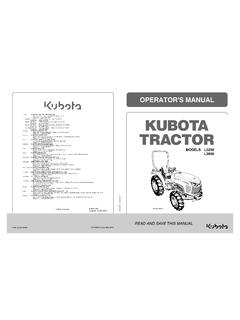Transcription of RC Cheat Sheets - Petit RC
1 Page | 1 RC Cheat Sheets Set Up Your Radio-Control Car to Win! Page | 2 Index GENERAL Page No: Ackermann 5 Anti-dive (on road) 6 Anti-roll Bars, Sway Bars 7 Anti-squat, off road 8 Anti-squat, on road 9 Axle Height, off road 10 Bump Steer 11 Camber, front 12 Camber Link, front 13 Camber Link, rear 14 Camber, rear 15 Caster, front 16 Chassis Length 17 Diff Fluid, Centre Diff, off-road 18 Diff Fluid, Front Diff, off-road 19 Diff Fluid, Front Diff, onroad 20 Diff Fluid, Rear Diff, off-road 21 Diff Fluid, Rear Diff, onroad 22 Droop (on road) 23 Final Drive Ratio 24 Gear Pitch 25 Gear Ratio 26 Kickup 27 Pinion Gear 28 Ride Height, front 29 Ride Height, rear 30 Roll Centre 31 Shock Mounting, front A-arm 35 Shock Mounting, front tower 36 Shock Mounting, rear A-arm 37 Shock Mounting, rear shock tower 38 Shock Fluid 39 Shock Pistons 40 Shock Springs 41 Shock Travel Limiters 42 Slipper Clutch 43 Spur Gear 44 Tyre Compound 45 Tyre Inserts, foam 46 Tyre Profile 47 Tyre Sauce, Tyre Additive 48 Toe-in, toe-out, front 49 Weight Distribution, adding weights 50 Wheelbase 51 Wing 52 Page | 3 Index ELECTRICAL Page No.
2 53 Battery "C" Rating, LiPo 54 Battery mAh Capacity 55 Battery Cell Count 56 Battery Label (NiCd and NiMH) 57 Battery Placement 58 Battery Voltage 59 Drag brake 60 Dual Rate (D/R) 61 Expo/Exponential, steering servo 62 EPA/End Point Adjustment, steering servo 63 EPA/ATV/End Point Adjustment, throttle/ brake 64 Brushless Motor Speed, KV 65 Motor Springs, brushed motors 66 Motor Timing, brushed motor 67 Motor Turns, brushed motor 68 Sintered Rotor, brushless motors 69 Steering Servo 70 Soldering Tips 113 Index NITRO Page No: 71 Carb Restrictor 72 Carb: High-speed Needle 73 Carb: Idle Adjustment Screw 74 Carb: Low-speed Needle 75 Clutch Bell 76 Clutch Shoes 77 Clutch Springs 78 Index PAN CARS Page No: 79 Active Strut Upper Arm Mount 80 Battery Placement, oval 81 Centre Damping 82 Centre Spring 83 Inline/Trailing Axle 84 Kingpin Damping 85 Kingpin Springs 86 Rear Pod, oval 87 Side Damping, rear 88 Side Springs, rear 89 T-Bar Flex, oval 90 Page | 4 Index LISTMANIA Page No: 91 Maintenance Checklist 92 RC Toolbox, electric 94 RC Toolbox, nitro 96 Checklist: How to Go Faster 98 Checklist: Common Beginner Mistakes 99 COMPARISONS Page No: 100 2WD vs.
3 4WD Vehicles 101 Brushed vs. Brushless Motors 102 Bushings vs. Bearings 103 Electric vs. Nitro Vehicle 104 Kit vs. Ready-to-Run Vehicle 105 Onroad vs. Off-road Vehicle 106 Pullstart vs. Non-pullstart Engines 107 Racing vs. Bashing 108 Graphite vs. Standard Material 109 Truck vs. Buggy 110 Choosing your RC car 111 APPENDIX Page No: 112 Soldering Tips 113 Page | 5 Ackermann less Ackermann more aggressive steering harder to drive more Ackermann less aggressive steering easier to drive Ackermann is a term describing the effect of the inside front wheel turning tighter than the outside front wheel. More Ackermann means the inside wheel is turning in a tighter arc. You change Ackermann settings in the buggy by moving the connection from the current holes (standard Ackermann) to the lower holes.
4 Page | 6 Anti-dive (onroad) lower angle decreasing anti-dive adding anti-dive larger angle increases corner entry steering increases caster at the wheel This setting refers to the angle of the front arm mount when the rear arm mount is higher than the front arm mount. The "dive" refers to the tendency of the front end to dive, or lower, when braking. Anti-roll bars can also help balance the pressure between the front and rear. If your car is oversteering, consider adding a front anti-roll bar only (or making the front bar thicker than the rear). If your car is understeering, consider adding a rear anti-roll bar only (or making the rear bar thicker than the front). Page | 7 Anti-roll Bars, Sway Bars softer or thinner bars for low and med. bite tracks stiffer or thicker bars for high traction tracks Anti-roll bars are used to stabilize a vehicle from excessive chassis roll (such as when a buggy leans through the turns by centrifugal force).
5 On a high-traction surface, a vehicle not using anti-roll bars will tend to have a lot of chassis roll, which results in the vehicle being less responsive. Adding anti-roll bars (or making them thicker if you already have them on) will help minimize the chassis roll, making the vehicle more responsive in cornering, and at the same time making it more stable. Roll bar on the front of the #30106 Factory Team TC6 1:10 scale electric touring car. Page | 8 Anti-squat, off-road less anti-squat more side traction in corners more rear traction for slick or bumpy surfaces more anti-squat less side traction in corners more rear lift in jumps Anti-squat denotes the angle of the rear arms relative to the chassis, when looked at from the side. 0 deg. anti-squat means that the rear arms are flat, parallel with the chassis. 2 deg. anti-squat means the front of the rear arms are creating a 2 deg. angle to the chassis.
6 This photo shows a 2 deg. anti-squat angle on the rear of an buggy. Change anti-squat by placing shims underneath the front of the rear arm mounts, angling them higher. Page | 9 Anti-squat, onroad decreasing less steering entering corner improve acceleration over bumps increasing more steering entering corner more traction exiting corner Anti-squat denotes the angle of the rear arms relative to the chassis, when looked at from the side. 0 deg. anti-squat means that the rear arms are flat, parallel with the chassis. 2 deg. anti-squat means the front of the rear arms are creating a 2 deg. angle to the chassis. Page | 10 Axle Height, off-road lower more steering entering corners less steering exiting corners higher less steering entering corners more steering exiting corners The front axle height on Team Associated 2WD off-road vehicles (such as the B4, T4, and SC10) can be raised or lowered to optimize handling for different track conditions.
7 By moving both spacers to the top or bottom, you can change the axle height. Page | 11 Bump Steer fewer washers bumpsteer in less steering More stability more washers bumpsteer out more aggressive less stable Bump Steer takes its name from the fact that when the car goes over "bumps," it changes the "steering." Bump steer is the undesirable effect of extra toe-in or toe-out as your car goes over randomly-spaced hilly bumps closely spaced together in an area, making your steering unpredictable. Your car then bounces back and forth instead of going straight through the bumps. You modify bump steer by adding or removing spacers on this ballstud. Page | 12 Camber, front less (0 deg.) more straight-line acceleration tyre is vertical more (2 deg.) more high-speed traction through turns tyre leans inward Camber describes the angle at which the tyre and wheel leans toward the car when looked at from the front or back.
8 Negative camber means that the tyre leans inward at the top. Positive camber means that the tyre leans outward at the top. (Positive camber is not recommended.) Camber is measured in degrees. You can use Associated's #1719 camber gauge to set your camber. The front camber of the is being checked with the #1719 Factory Team Camber + Track Width Tool Camber Gauge. The number at the bottom corner of the gauge nearest the tyre indicates the angle of camber. Page | 13 Camber Link, front shorter link standard for high-grip tracks more corner entry steering less mid and exit corner steering longer link better for loose tracks less corner entry steering more exit steering The front camber link is the turnbuckle link connecting the ballstud on the shock tower to the ballstud on the caster block. Lengthening or shortening the camber links can affect traction, stability, and handling. You lengthen or shorten the camber link by mounting the camber link turnbuckle in one of two holes in the tower (SC10 short-course truck shown).
9 Page | 14 Camber Link, rear shorter link better for loose tracks stiffer rear suspension accelerate better more turn-in steering less mid-to-exit corner steering decreases traction more side-to-side stability longer link standard for high-grip tracks softer rear suspension (more chassis roll) less corner entry steering more exit corner steering more traction less side-to-side stability The camber link is the turnbuckle that connects the ballstud on the shock tower to the ballstud on the rear hub. Lengthening or shortening the camber link turnbuckles can affect traction, stability, and handling. The camber link will affect how much the camber changes during suspension travel. The longer the link, the less camber change, and the more traction. The shorter the link, the more camber change, and the less traction. This vehicle provides two mounting options for the shock tower ballstud. Page | 15 Camber, rear less (-2 deg.)
10 More high-speed traction through corners tyre leans inward more (2+ deg.) removes straight-line acceleration tyre leans outward Camber describes the angle at which the tyre and wheel leans toward the car when looked at from the front or back. Negative camber means that the tyre leans inward at the top. Positive camber means that the tyre leans outward at the top. At zero degrees, the tyre is vertical; benefit of zero camber is more straight-line acceleration than positive camber. Camber is measured in degrees. The rear camber of the is being checked with the #1719 Factory Team Camber + Track Width Tool Camber Gauge. The number at the bottom corner of the gauge nearest the tyre indicates the angle of camber. Page | 16 Caster, front less caster less steering entering corners more steering exiting corners more caster more steering entering corners less steering exiting corners Caster describes the angle of the kingpin when it is leaning toward the rear of the vehicle.
